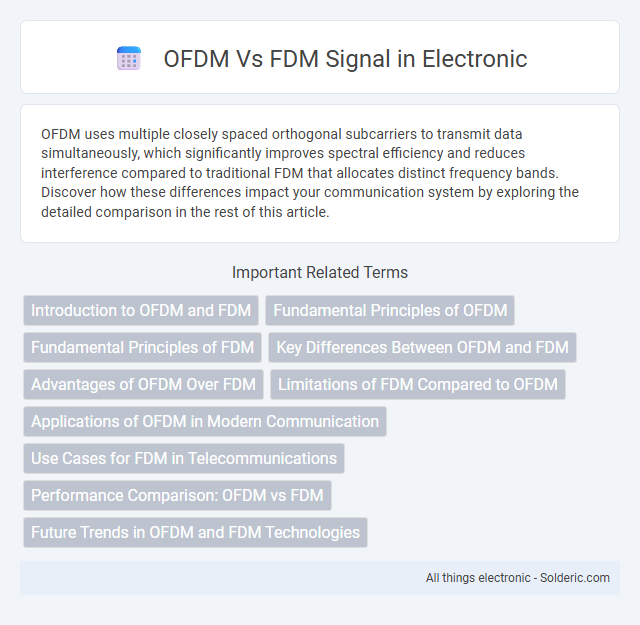OFDM uses multiple closely spaced orthogonal subcarriers to transmit data simultaneously, which significantly improves spectral efficiency and reduces interference compared to traditional FDM that allocates distinct frequency bands. Discover how these differences impact your communication system by exploring the detailed comparison in the rest of this article.
Comparison Table
| Feature | OFDM (Orthogonal Frequency Division Multiplexing) | FDM (Frequency Division Multiplexing) |
|---|---|---|
| Definition | Divides the spectrum into orthogonal sub-carriers, transmitting data in parallel. | Allocates separate frequency bands for each channel without overlap. |
| Orthogonality | Yes, sub-carriers are orthogonal, minimizing interference. | No strict orthogonality; guard bands prevent overlap. |
| Spectrum Efficiency | High, due to overlapping orthogonal sub-carriers. | Lower, uses guard bands reducing bandwidth utilization. |
| Interference | Lower inter-carrier interference due to orthogonality. | Potential cross-channel interference if guard bands are inadequate. |
| Implementation Complexity | Higher, requires FFT/IFFT processing and precise synchronization. | Lower, simpler filtering and frequency allocation. |
| Application | Used in modern broadband standards: LTE, Wi-Fi, DVB-T. | Used in traditional analog communication: radio, TV broadcasting. |
| Resistance to Multipath Fading | High, handles multipath with cyclic prefix. | Low, susceptible to interference and fading. |
| Data Rate | Supports high data rates through parallel transmission. | Limited by allocated bandwidth per channel. |
Introduction to OFDM and FDM
OFDM (Orthogonal Frequency Division Multiplexing) and FDM (Frequency Division Multiplexing) are techniques used to transmit multiple signals simultaneously over a shared communication channel. OFDM divides the bandwidth into many closely spaced orthogonal subcarriers, minimizing interference and improving spectral efficiency. FDM separates the channel into distinct frequency bands for each signal, reducing overlap but requiring more bandwidth to avoid crosstalk.
Fundamental Principles of OFDM
Orthogonal Frequency Division Multiplexing (OFDM) uses closely spaced orthogonal subcarriers to transmit data simultaneously, minimizing interference and improving spectral efficiency compared to traditional Frequency Division Multiplexing (FDM). Each subcarrier in OFDM is mathematically orthogonal, allowing overlapping spectra without crosstalk, which significantly enhances data throughput and robustness against multipath fading. Your communication system benefits from OFDM's ability to handle high data rates and noisy environments while optimizing bandwidth usage.
Fundamental Principles of FDM
Frequency Division Multiplexing (FDM) divides the available bandwidth into separate frequency bands, each carrying an individual signal simultaneously without overlapping. Each channel is assigned a unique frequency range, ensuring minimal interference by using guard bands to separate adjacent frequencies. Your communication system benefits from FDM's ability to transmit multiple signals concurrently over a single medium, optimizing bandwidth utilization in analog and certain digital transmissions.
Key Differences Between OFDM and FDM
OFDM (Orthogonal Frequency Division Multiplexing) uses overlapping subcarriers that are orthogonal to each other, enabling higher spectral efficiency compared to FDM (Frequency Division Multiplexing), which separates frequency bands with guard intervals to avoid interference. OFDM's robustness to multipath fading and inter-symbol interference makes it ideal for wireless communication systems, whereas FDM is commonly used in traditional analog and simple digital transmissions. Your choice between OFDM and FDM impacts bandwidth utilization, signal resilience, and system complexity.
Advantages of OFDM Over FDM
OFDM offers superior spectral efficiency compared to FDM by overlapping subcarrier signals without causing interference, thanks to its orthogonal design. It provides enhanced resistance to multipath fading and inter-symbol interference, significantly improving reliability in wireless communications. OFDM also simplifies equalization processes, reducing the complexity and cost of receivers in broadband data transmission systems.
Limitations of FDM Compared to OFDM
FDM (Frequency Division Multiplexing) suffers from limited spectral efficiency and increased interference due to fixed guard bands between channels, causing wasted bandwidth. OFDM (Orthogonal Frequency Division Multiplexing) overcomes these limitations by using overlapping subcarriers that are mathematically orthogonal, providing higher data rates and better resistance to multipath fading. Your communication system can achieve enhanced performance and spectral efficiency by adopting OFDM instead of traditional FDM schemes.
Applications of OFDM in Modern Communication
OFDM (Orthogonal Frequency Division Multiplexing) is extensively applied in modern communication systems such as 4G LTE, 5G NR, Wi-Fi (802.11a/g/n/ac/ax), and digital broadcasting (DVB-T/T2). Its ability to efficiently combat multipath fading and spectrum efficiency makes it ideal for high-speed wireless data transmission, unlike traditional FDM (Frequency Division Multiplexing), which allocates separate frequency bands without orthogonality. OFDM's robustness to interference and adaptability to varying channel conditions have revolutionized broadband internet, mobile networks, and multimedia streaming applications.
Use Cases for FDM in Telecommunications
Frequency Division Multiplexing (FDM) is widely utilized in traditional radio broadcasting, enabling multiple radio stations to transmit simultaneously over distinct frequency bands without interference. It is also employed in telephone networks to divide bandwidth among multiple calls, facilitating concurrent voice communication channels. Moreover, FDM plays a crucial role in satellite communication systems to allocate separate frequency slots to various data streams, optimizing the efficient use of the available spectrum.
Performance Comparison: OFDM vs FDM
OFDM (Orthogonal Frequency Division Multiplexing) outperforms FDM (Frequency Division Multiplexing) by providing higher spectral efficiency and better resilience to multipath fading and interference due to its use of orthogonal subcarriers. OFDM's ability to mitigate inter-symbol interference through cyclic prefix insertion significantly improves signal reliability in wireless communications compared to traditional FDM systems. Moreover, OFDM supports higher data rates and improved channel capacity, making it the preferred choice for modern broadband technologies such as LTE and Wi-Fi.
Future Trends in OFDM and FDM Technologies
Future trends in OFDM technologies emphasize enhanced spectral efficiency and robustness against multipath fading, making OFDM ideal for 5G and beyond wireless communication systems. FDM continues to evolve with improved filter designs and adaptive allocation techniques, supporting legacy and niche applications where simple frequency separation is sufficient. Your choice between OFDM and FDM will depend on requirements for bandwidth efficiency and interference management in upcoming communication infrastructures.
OFDM vs FDM signal Infographic

 solderic.com
solderic.com